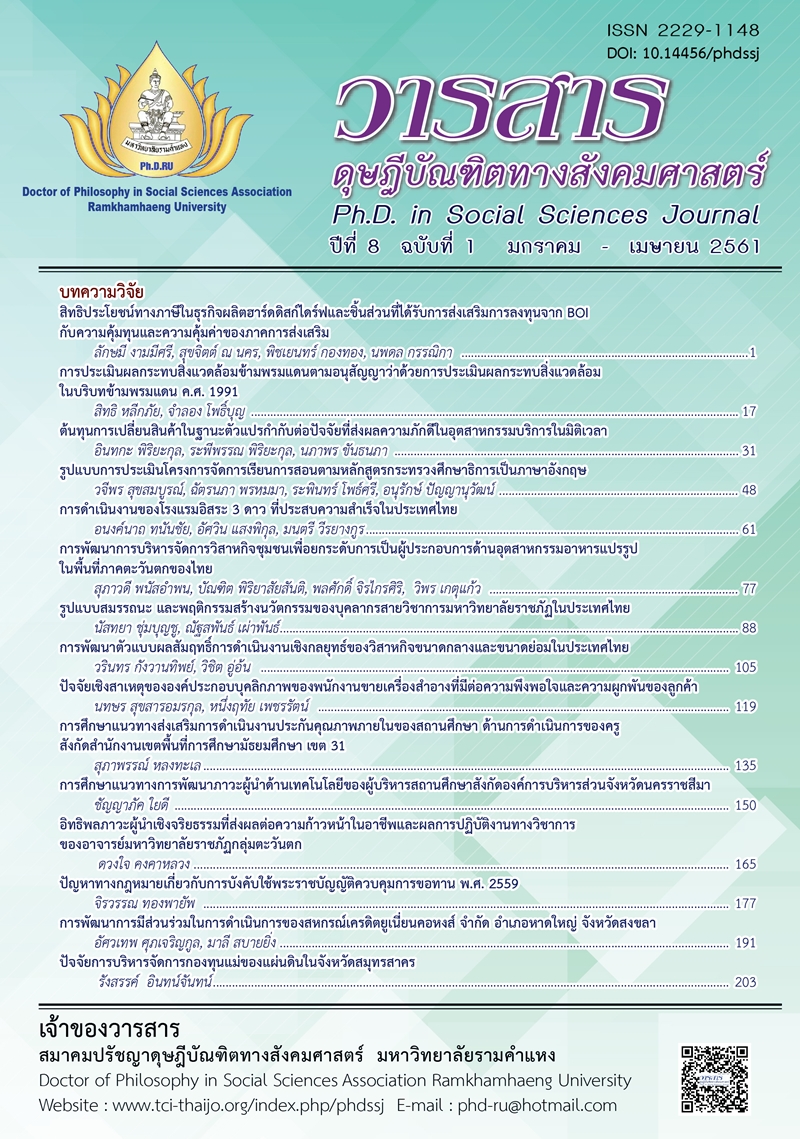THE MODERATING ROLE OF SWITCHING COSTS ON SERVICE LOYALTY: THE TEMPORAL DIMENSION
Main Article Content
Abstract
This research aims to investigate the effect of time dimension from the time sequences of Structural Equation as canonical analysis correlation. Our study formulates the panel data onto the results of Yangon et al.’s research (2009), which consists of 3 independent factors: Satisfaction, Service Quality, and Service Value, 4 dependent factors: Repurchase, Applicable Behavior, Complaint Behavior and Customer Tolerance and the data was conducted during the period 2002- 2006. The analysis using multiple regression with the lag time of each independent factor and the exploration has found that only Satisfaction factor has one lag time for the predicting model of Repurchase, Applicable Behavior and Customer Tolerance with significant level 10 percent and 5 percent to society and the country.
Article Details
Academic articles, research articles, and book reviews in the Ph.D. in Social Sciences Journal are author’s opinions, and not the publisher’s, and is not the responsibility of the Ph.D. in Social Sciences Journal Philosophy Association, Ramkhamhaeng University. (In the case that research is done on human, the researcher has to be trained in Ethics for Doing Research on Human Training and has to produce the evidence of the training).
References
Bell, C. R. (1994). Turning disappointment into customer delight. Editor and Publisher, 127(32), 48-49.
Blattberg, R. C., Getz, G., & Thomas, J. (2001). Customer equity. Boston: HBS Press.
Bozzo, C. (2002). Understanding inertia in an industrial context. Journal of Customer Behaviour, 1(3), 335-355.
Burnham, T. A., Frels, J. K., & Mahajan, V. (2003). Consumer switching costs: A typology, antecedents, and consequences. Journal of the Academy of Marketing Science, 31(2), 109-126.
Colgate, M., & Lang, B. (2001), Switching barriers in consumer markets: An investigation of the financial services industry. Journal of Consumer Marketing, 18(4), 332-347.
Dick, A. S., & Basu, K. (1994). Customer loyalty: Toward an integrated conceptual framework. Journal of the Academy of Marketing Science, 22(2), 99-113.
Heide, J. B., & Weiss, A. M. (1995), Vendor consideration and switching behavior for buyers in high-technology markets. Journal of Marketing, 59(3), 30-43.
Hogan, J. E., Lehmann, D. R., Merino, M., Srivastava, R., & Thomas, J. (2002). Linking customer assets to financial performance. Journal of Service Research, 5(1), 26–38.
Hoschka, P., & KloÈsgen, W. (1991). A support system for interpreting statistical data. In G. Piatetsky-Shapiro & W. J. Frawley (Eds.), Knowledge discovery in databases: An overview (pp.325-345), Cambridge, MA: MIT Press.
Jones, M. A., Mothersbaugh, D. L., & Beatty, S. E. (2002). Why customers stay: Measuring the underlying dimensions of services switching costs and managing their differential strategic outcomes. Journal of Business Research, 55(6), 441-450.
Kelley, S., & Davis, M. (1994). Antecedents to customer expectations for service recovery. Journal of the Academy of Marketing Science, 22(1), 52-61.
Kuo, Y., & Ye, K. (2009). The causal relationship between service quality, corporate image and adults’ learning satisfaction and loyalty: A study of professional training programmes in a Taiwanese vocational institute. Total Quality Management and Business Excellence, 20(7), 749-762.
Lee, C., Kim, S., & Lim, J., (2006). The role of corporate image in the NCSI model. Journal of International Consumer Marketing, 19(1), 7-34.
Nyadzayo, M. (2010). The mediating role of customer relationship management on customer retention at selected motor vehicle dealership in the Buffalo City Municipality, University of Fort Hare, South Africa.
Oliver, R. L. (1999). Whence customer loyalty. Journal of Marketing, 63(special), 33-44.
Ranaweera, C., & Neely, A. (2003), Some moderating effects on the service quality-customer retention link. International Journal of Operations & Production Management, 23(2), 230-248.
Schneider, B., & Bowen, D. (1999), Understanding customer delight and outrage. MIT Sloan Management Review, 41(1), 35-45.
Shun, Y. L., Venkatesh, S. M., & Krishna, E. (2004). Customer value, satisfaction, loyalty, and switching costs: An illustration from a business-to-business service context. Journal of The Academy of Marketing Science, 32(3), 293-311.
Wilson, D., Soni, P., & Keeffe, M. (1995). Modeling customer retention as a relationship problem. Institute for the Study of Business Markets, ISBM Report #13-1995, The Pennsylvania State University, U.S.A.
White, L., & Yanamandram, V. (2004). Why customers stay: Reasons and consequences of inertia in financial services. Managing Service Quality, 14(2/3),183-194.
White, L., & Yanamandram, V. (2007). A model of customer retention of dissatisfied business services customers. Managing Service Quality, 17(3), 298-316.
Yanchi, L., Chuanren, L., Meng, Q., & Hui. X. (2016). Exploiting temporal and social factors for B2B marketing campaign recommendations, ACM. https://dx.doi.org/10.1145/2939672.2939773
Yanamandram, V. K., & White, L. (2006). Switching barriers in business-to-business services: A qualitative study. International Journal of Service Industry Management, 17(2), 158-192.
Yanqun, H., Shuk-Man, C., & Siu-Keung, T. (2009). The role of switching costs on service loyalty: A canonical correlation analysis. Journal of Chinese Entrepreneurship, 1(2), 154-164.
Zhang, J., Dixit, A., & Friedmann, R. (2010). Customer loyalty and lifetime value: An empirical investigation of consumer packaged goods. Journal of Marketing Theory & Practice, 18(2), 127-140.

